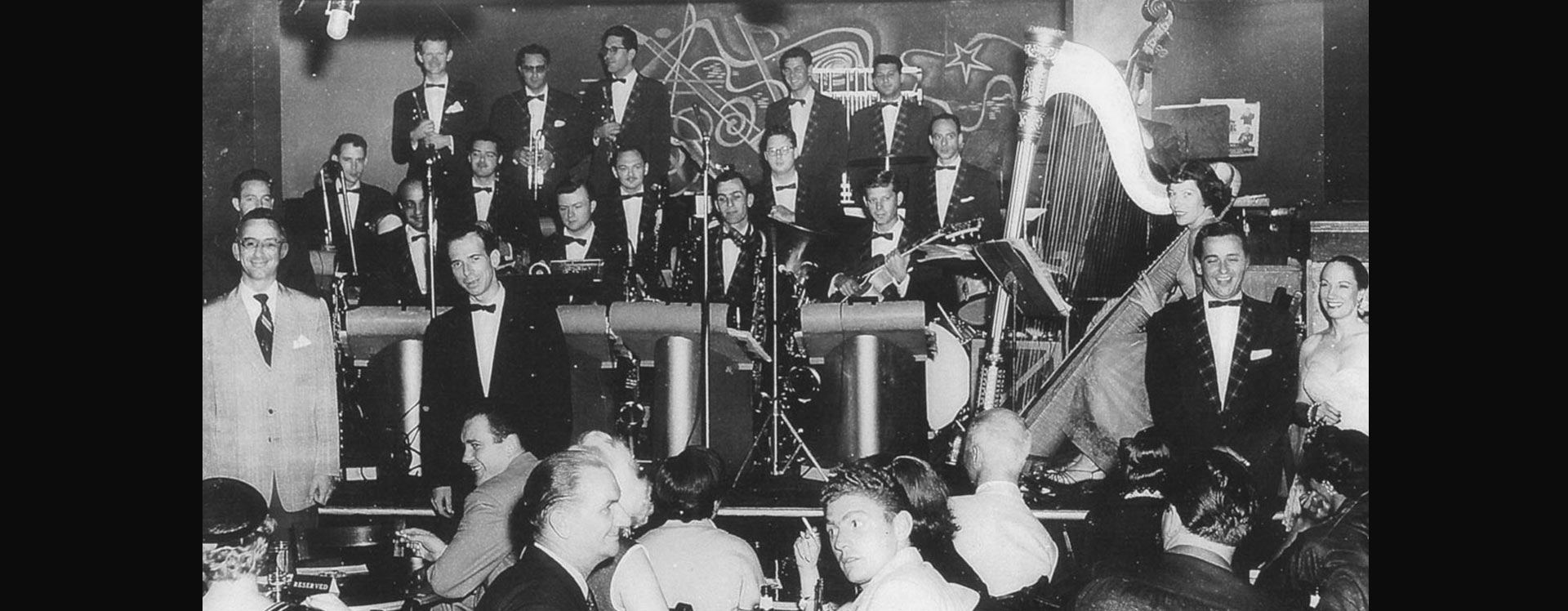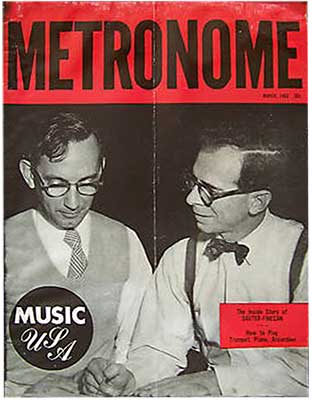

Photo above: The Sauter-Finegan Orchestra at the Blue Note circa 1953. Below: Bill Finegan and Eddie Sauter on the cover of Metronome Magazine, March 1953.
While they were writing for two of the biggest names in big band history (Goodman and Miller), Eddie Sauter and Bill Finegan were well aware of each other's work. Sauter remarked that the two met early on after Finegan had joined Miller, but that all their conversations were simply carried out in passing.
Both expressed great admiration for the other's work before, during, and after their eventual collaboration. Reflecting on their works up to 1952, the two did seem to be a well-suited pair; both Eddie and Bill were soft-spoken, pensive composer/arrangers from the Northeast who had taken up careers writing for swing bands but were always yearning for their often complex music to have a deeper meaning than simply providing a danceable tune.
It was while Sauter was recovering from a bout of tuberculosis in 1950, that Finegan sent him a letter expressing his desire to start a band together. Eddie Sauter recalled the main sentiment of the letter: "'We can't get along any other way. We might as well prop one another up,' which is pretty much what it was."
When Finegan was contracted by Johnny Mercer to work on his forthcoming musical, "Top Banana," he asked Sauter to assist. Thus began the working relationship of Eddie Sauter and Bill Finegan.
It was time to lay the groundwork for what Time magazine called "the most original band heard in the U.S. in years." (Time, Aug 11, 1953)
About Bill Finegan
Bill Finegan and Eddie Sauter were, in fundamental ways, kindred musical spirits. Each drew sustenance from classical music. Each emphasized counterpoint as an essential ingredient in their approach to composition. And each eagerly embraced the variety of orchestral colors that became available to them along the way.
Finegan had a consuming interest in harmonic possibilities. He combined this trait with contrapuntal inventiveness and melodic grace to create rich tapestries of orchestral sound. Notable also was the sense of humor he brought to this mix. These attributes were part of a remarkable musical personality; a Finegan "chart" is unmistakable.
The work that originally put Finegan on the map was an everything-but-the-kitchen-sink arrangement of the popular tune "Lonesome Road." This work for Tommy Dorsey in 1939, took up two sides of a 10-inch LP. It featured advanced counterpoint, clever modulations, and creative orchestration from the 21-year-old arranger.
Dorsey, who didn't have room for Finegan in the band, passed him on to an emerging bandleader at that time by the name of Glenn Miller.
Finegan arranged Glenn Miller's first major hit, "Little Brown Jug," along with "It's Always You" and "I Love the Stars" — some of the more beautiful charts in the Glenn Miller songbook. He remained a staff writer for Miller until 1942.
As trombonist Eddie Bert recalled, Finegan's Army service during WWII was carried out at Camp Shanks in Orangeburg, NY. There, Finegan led a band (that included Bert) and mostly played for shows that were performed on the base. Orangeburg was just a stone's throw away from Sauter's perennial home in nearby Nyack. Sauter and Finegan apparently would meet up to chat in the evenings.

Recommended: Listen on headphones or external speakers.
Tommy Dorsey & His Orchestra
"The Continental" – June, 1949
Bill Finegan arrangement
Sauter-Finegan Orchestra
"Child's Play" – February, 1953
Bill Finegan composition
"Autumn Leaves" – February, 1954
Bill Finegan arrangement
Vocal by Sally Sweetland
"We can't get along any other way. We might as well prop one another up." — Bill Finegan